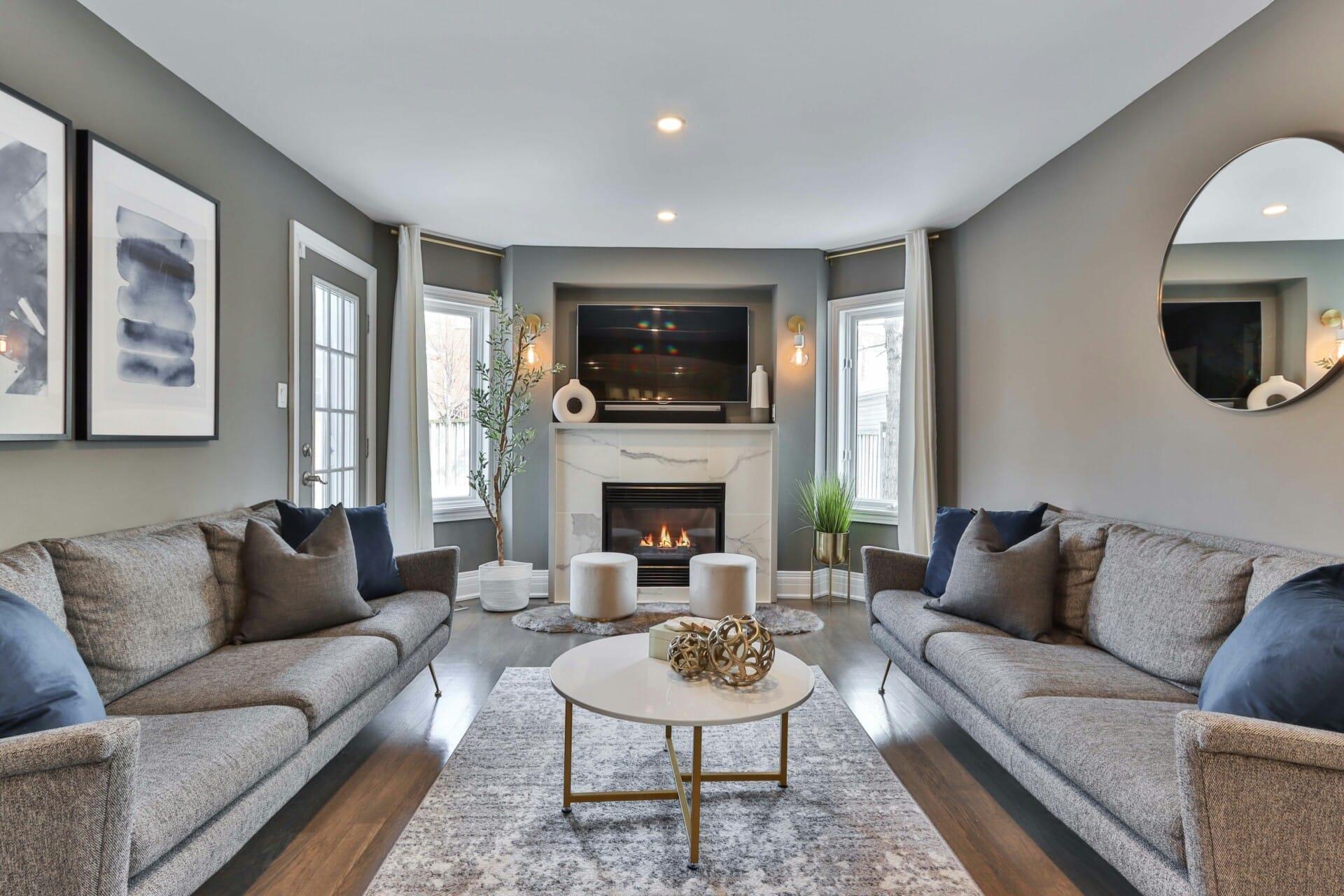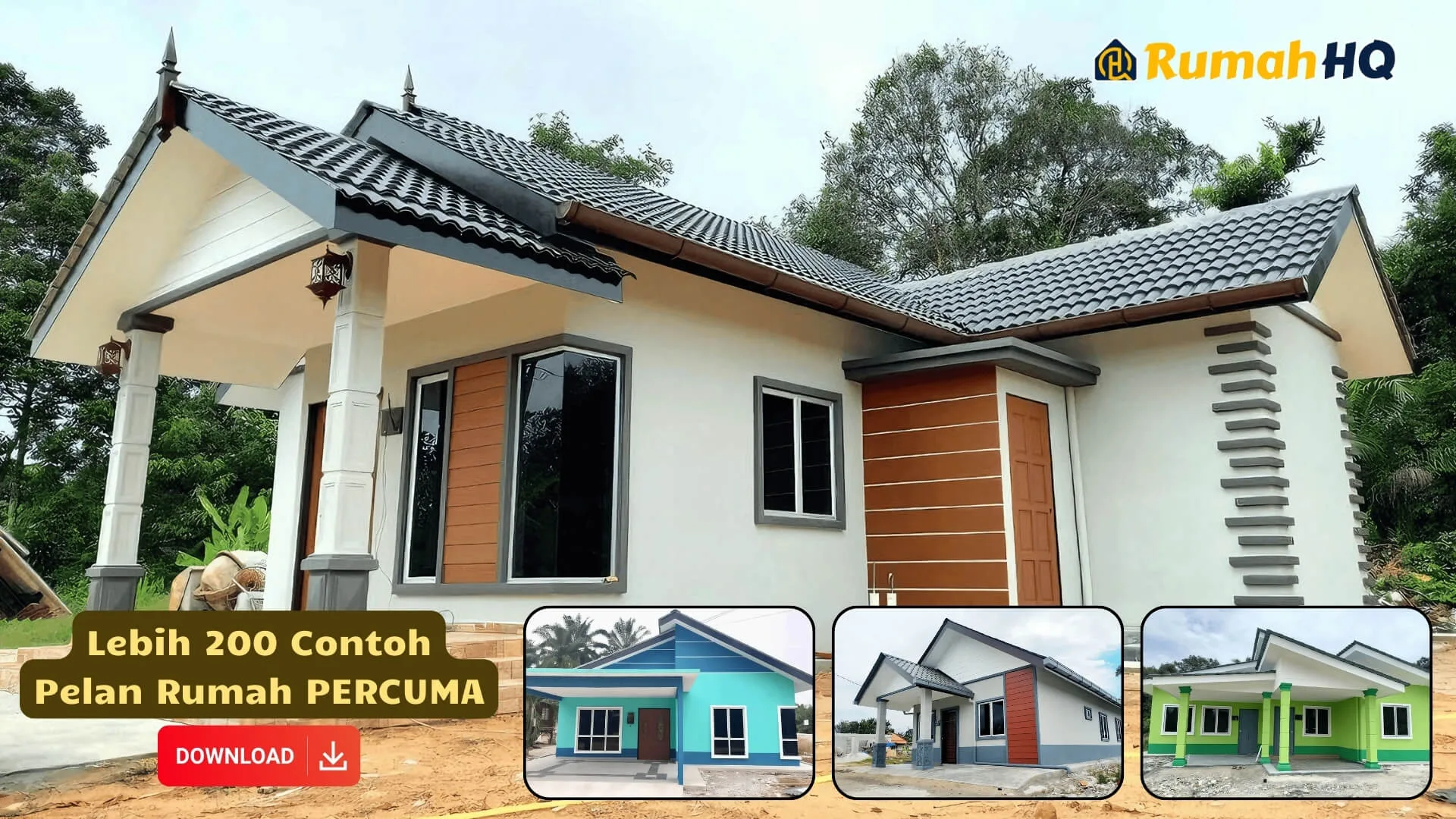
Blog
8 Rahsia Rumah Tahan Gempa Yang Ramai Tak Tahu! Jangan Sampai Rumah Jadi Runtuh Macam Biskut Marie! | RumahHQ

1. Asas Rumah Tahan Gempa: Bukan Sekadar Letak Batu Je!
Korang pernah tengok video rumah runtuh masa gempa bumi? Ngeri kan? Tapi jangan risau, sebab kita ada solusi! Asas rumah tahan gempa bukan sekadar letak batu je, tapi ada prinsip-prinsip penting yang kena ikut.
Pertama sekali, kita kena faham 3 tahap ketahanan rumah terhadap gempa:
- Gempa lemah: Rumah tak rosak langsung.
- Gempa sederhana: Hanya bahagian bukan struktur yang rosak sikit.
- Gempa kuat: Boleh rosak, tapi tak sampai runtuh.
Untuk capai tahap ni, kita kena ambil kira beberapa faktor penting:
- Beban struktur: Berapa berat rumah tu?
- Jenis tanah: Tanah lembut ke keras?
- Peak Ground Acceleration (PGA): Berapa kuat getaran tanah kat kawasan tu?
Nah, sekarang kita tengok jenis-jenis asas rumah yang sesuai untuk kawasan berisiko gempa:
| Jenis Asas | Kesesuaian | Kelebihan |
|---|---|---|
| Asas Cetek (Shallow) | Rumah kecil hingga sederhana | Mudah dibina, kos rendah |
| Pad Footing | Tanah keras, beban sederhana | Fleksibel, sesuai untuk tiang |
| Strip Footing | Tanah sederhana, beban sekata | Bagus untuk dinding bearing |
| Raft Foundation | Tanah lembut, beban besar | Sekata, kurang settlement |
| Asas Dalam (Deep) | Bangunan besar, tanah lembut | Lebih stabil, tahan beban tinggi |
| Cerucuk (Pile) | Tanah sangat lembut | Pindah beban ke lapisan tanah keras |
Tapi ingat, bukan semua asas ni sesuai untuk semua keadaan. Kena pilih yang betul mengikut keadaan tanah dan jenis rumah korang. Kalau tak sure, tanya pakar lah ye!
Lepas tu, kena pastikan sambungan antara asas dan struktur atas tu kuat. Tak guna la asas kukuh tapi sambungan lemah, nanti masa gempa boleh tercabut macam gigi susu je!
Akhir sekali, jangan lupa pasal pengawalan mutu masa proses pembinaan. Kalau campuran konkrit tak betul ke, tetulang tak cukup ke, semua tu boleh jadi masalah besar masa gempa nanti.
So, asas rumah tahan gempa ni bukan main-main. Kena ambil kira banyak faktor dan buat dengan betul. Kalau tak, nanti rumah korang boleh jadi macam biskut marie yang senang je pecah masa gempa!
2. Jenis-jenis Asas Rumah: Pilih Yang Mana? Pad, Strip, atau Cerucuk?
Okay, sekarang kita nak dive in sikit pasal jenis-jenis asas rumah. Macam pilih kasut lah, kena yang sesuai dengan kaki (atau dalam kes ni, tanah) kita. Jom kita tengok satu-satu:
Asas Cetek (Shallow Foundation)
- Pad Footing
- Macam tapak kaki gajah
- Sesuai untuk: Rumah kecil hingga sederhana, tanah keras
- Pro: Mudah buat, jimat kos
- Con: Tak sesuai untuk tanah lembut
- Strip Footing
- Macam jalur panjang bawah dinding
- Sesuai untuk: Rumah dengan dinding bearing, tanah sederhana
- Pro: Bagus untuk agih beban sekata
- Con: Kos lebih tinggi sikit dari pad footing
- Raft Foundation
- Macam lantai konkrit besar bawah seluruh rumah
- Sesuai untuk: Tanah lembut, beban besar
- Pro: Kurangkan risiko settlement tak sekata
- Con: Mahal sikit, tapi worth it untuk tanah lembut
Asas Dalam (Deep Foundation)
- Cerucuk (Pile)
- Macam tiang panjang masuk dalam tanah
- Sesuai untuk: Bangunan besar, tanah sangat lembut
- Pro: Boleh pindah beban ke lapisan tanah yang lebih keras
- Con: Mahal, tapi paling selamat untuk kawasan berisiko tinggi
Nah, untuk senangkan korang faham, jom tengok table perbandingan ni:
| Jenis Asas | Kesesuaian Tanah | Kos Relatif | Ketahanan Gempa |
|---|---|---|---|
| Pad Footing | Keras | $ | ★★☆ |
| Strip Footing | Sederhana | $$ | ★★★ |
| Raft Foundation | Lembut | $$$ | ★★★★ |
| Cerucuk (Pile) | Sangat Lembut | $$$$ | ★★★★★ |
Tapi ingat, bukan yang paling mahal tu yang paling best. Kena pilih yang sesuai dengan keadaan tanah dan jenis rumah korang. Macam mana nak tau yang mana sesuai? Cuba ikut guideline ni:
- Buat soil investigation dulu. Tau jenis tanah baru boleh pilih asas yang sesuai.
- Tengok beban rumah. Rumah 2 tingkat dengan rumah 5 tingkat lain asas dia.
- Check kawasan. Kalau kat kawasan berisiko gempa tinggi, better ambil yang lebih kukuh sikit.
- Bajet. Memang la yang mahal tu lebih secure, tapi kena ikut bajet jugak.
Lepas tu, kena ingat sambungan antara asas dengan struktur atas tu penting gila. Tak guna la asas kukuh tapi sambungan lemah, nanti boleh tercabut macam gigi susu je masa gempa!
Last sekali, jangan lupa pasal quality control masa proses pembinaan. Kalau campuran konkrit tak betul ke, tetulang tak cukup ke, semua tu boleh jadi masalah besar masa gempa nanti.
So, pilih asas rumah ni bukan main hentam keromo je. Kena fikir panjang dan minta nasihat pakar kalau tak sure. Better spend sikit time dan duit sekarang daripada rumah jadi macam biskut marie yang senang je pecah masa gempa kan?
3. Bahan Binaan Berkualiti: Jangan Main Kedekut, Nanti Menyesal!
Korang tau tak, bahan binaan tu macam bahan masak la. Kalau guna bahan murahan, hasil pun tak sedap. Same goes untuk rumah. Guna bahan tak berkualiti, nanti rumah pun tak tahan lama. Apatah lagi kalau kena gempa bumi!
Kenapa Bahan Berkualiti Tu Penting?
- Kekuatan: Bahan berkualiti lebih kuat dan tahan lasak.
- Ketahanan: Boleh bertahan lama tanpa rosak.
- Keselamatan: Kurangkan risiko kerosakan masa gempa.
- Jimat Jangka Panjang: Mungkin mahal sikit awal, tapi jimat kos maintenance.
Jenis-jenis Bahan Binaan Untuk Rumah Tahan Gempa
- Konkrit
- Mesti guna campuran yang betul
- Kena curing dengan baik
- Jangan main air lebih-lebih!
- Keluli
- Pilih gred yang sesuai
- Pastikan tak berkarat
- Sambungan kena kuat
- Kayu
- Pilih jenis kayu yang tahan lasak
- Kena treat dengan baik
- Elakkan kayu yang senang reput
- Batu Bata
- Pilih yang berkualiti tinggi
- Pastikan ikut spesifikasi
- Jangan guna yang retak atau pecah
Nak senang faham? Jom tengok table ni:
| Bahan | Kelebihan | Kekurangan | Tahap Ketahanan Gempa |
|---|---|---|---|
| Konkrit | Kuat, tahan api | Berat | ★★★★☆ |
| Keluli | Fleksibel, ringan | Boleh karat | ★★★★★ |
| Kayu | Ringan, senang kerja | Boleh reput | ★★★☆☆ |
| Batu Bata | Murah, tahan api | Berat, rapuh | ★★☆☆☆ |
Tips Pilih Bahan Berkualiti
- Beli dari supplier yang dipercayai
- Jangan main murah sangat, nanti dapat barang reject
- Check review dan track record supplier tu
- Minta sijil kualiti
- Bahan yang bagus ada sijil macam MS, SIRIM
- Kalau takde sijil, better skip je
- Buat ujian kualiti
- Hantar sample bahan pergi lab untuk test
- Memang kos sikit, tapi berbaloi untuk keselamatan
- Jangan compromise kualiti untuk jimat
- Ingat, jimat sikit sekarang boleh jadi mahal kemudian
- Better spend sikit extra untuk dapat bahan yang tahan lama
- Konsult dengan pakar
- Kalau tak sure, tanya engineer atau kontraktor berpengalaman
- Dorang boleh bagi advice yang sesuai dengan projek korang
Bahaya Guna Bahan Tak Berkualiti
Korang nak tau apa boleh jadi kalau guna bahan murahan? Jom tengok:
- Retak dan Pecah: Bahan murah senang retak, nanti air boleh masuk, jadi masalah besar.
- Runtuh: Masa gempa, struktur yang guna bahan tak bagus senang je collapse.
- Kos Repair Tinggi: Nanti kena repair selalu, lama-lama mahal gila.
- Tak Selamat: Bayangkan la kalau dinding tiba-tiba runtuh sebab guna batu bata murah. Ngeri tak?
So, jangan la kedekut sangat bila beli bahan binaan. Ingat, rumah ni bukan main-main. Ia tempat kita berlindung, tempat keluarga berkumpul. Kalau guna bahan tak berkualiti, nanti bila ada apa-apa kejadian macam gempa bumi ke, kita yang susah.
Lagi satu, ingat ye. Bahan berkualiti je tak cukup. Kena pastikan cara guna dan pasang pun betul. Tak guna la beli bahan mahal tapi cara pasang cincai. Sama je macam beli ikan mahal tapi masak tak betul, hasil pun tak sedap juga kan?
Last sekali, jangan lupa buat maintenance yang proper. Bahan bagus pun kalau tak jaga, lama-lama rosak juga. So, invest sikit dalam bahan yang berkualiti, pasang dengan betul, dan jaga elok-elok. Baru la rumah korang boleh tahan lama dan selamat, walaupun kena gempa bumi!
4. Struktur Bangunan Bersepadu: Macam Team Work Lah!
Okay, korang. Sekarang kita nak bincang pasal struktur bangunan bersepadu. Ini bukan pasal batu dengan simen je, tapi macam mana semua bahagian rumah tu kena “team work” untuk tahan gempa. Macam BTS la, semua member kena sync baru show mantap!
Apa Tu Struktur Bersepadu?
Struktur bersepadu maksudnya semua bahagian rumah tu connected dan work together untuk resist force dari gempa. Macam squad game online la, semua kena main peranan masing-masing untuk menang.
Komponen Utama Struktur Bersepadu
- Asas (Foundation)
- Macam akar pokok la
- Kena strong untuk hold whole rumah
- Must connect properly dengan structure atas
- Tiang (Columns)
- Ni macam tulang rumah la
- Transfer load dari atas ke bawah
- Kena reinforce properly
- Rasuk (Beams)
- Connecting columns
- Distribute load evenly
- Work with columns to form frame
- **Lantai (Baiklah, saya akan menyambung artikel untuk Subtajuk 4:
- Lantai (Floors)
- Macam platform yang connect semua tiang dan rasuk
- Kena kuat untuk tahan beban atas dia
- Jadi diaphragm untuk distribute lateral forces
- Dinding Ricih (Shear Walls)
- Superhero yang resist lateral forces
- Bagi extra stability pada bangunan
- Crucial untuk tahan force gempa bumi
- Bumbung (Roof)
- Bukan sekadar tutup kepala je
- Kena tie in dengan whole structure
- Help distribute loads evenly
Nah, untuk senangkan korang faham, jom tengok table peranan setiap komponen ni:
| Komponen | Peranan Utama | Importance dalam Tahan Gempa |
|---|---|---|
| Asas | Transfer beban ke tanah | ★★★★★ |
| Tiang | Support beban vertikal | ★★★★☆ |
| Rasuk | Distribute beban horizontal | ★★★★☆ |
| Lantai | Act as diaphragm | ★★★☆☆ |
| Dinding Ricih | Resist lateral forces | ★★★★★ |
| Bumbung | Tie structure together | ★★★☆☆ |
Macam Mana Nak Buat Struktur Bersepadu?
- Proper Connection
- Semua joint kena strong
- Guna proper fasteners and welding
- No weak links allowed!
- Continuous Load Path
- Force from gempa mesti ada clear path to ground
- Tak boleh ada “missing link” dalam structure
- Symmetry and Regularity
- Simple, symmetric designs lagi bagus
- Irregular shapes boleh cause stress concentration
- Ductility
- Structure kena boleh bend sikit without breaking
- Macam bamboo la, flexible tapi strong
- Lightweight Materials
- Less mass = less inertial force during gempa
- But still need to be strong enough
Kenapa Struktur Bersepadu Penting?
- Better Load Distribution
- Force dari gempa distribute evenly
- No one part kena stress terlampau
- Increased Stability
- Whole structure move as one unit
- Kurang chance untuk collapse
- Flexibility with Strength
- Can absorb and dissipate energy from gempa
- Reduce damage to building
- Longer Lifespan
- Building can withstand repeated small quakes
- Less wear and tear over time
Bahaya Kalau Tak Bersepadu
Korang nak tau apa boleh jadi kalau structure tak bersepadu? Check ni:
- Pancake Collapse: Satu floor collapse, then semua ikut macam pancake. Ngeri gila!
- Soft Story Failure: Kalau ground floor weak, whole building boleh topple.
- Torsion: Building boleh twist and fail kalau tak symmetric.
- Pounding: Adjacent structures boleh “pukul” each other during gempa.
So, structure bersepadu ni bukan main-main. Ia macam orchestra la. Semua instrument kena play in harmony baru lagu sedap dengar. Same with rumah, all parts must work together baru boleh tahan gempa.
Ingat ye, bukan senang nak buat structure bersepadu ni. Kena ada proper planning, design, and execution. Kalau korang nak bina atau renovate rumah, better consult dengan structural engineer. Dorang boleh advise best way to make sure rumah korang punya structure betul-betul bersepadu dan tahan lasak.
Last sekali, jangan lupa regular maintenance. Even the best designed structure pun boleh jadi lemah kalau tak jaga properly. So, invest in good design, build it right, and take care of your home. Baru la rumah korang boleh stand strong, even when the earth decides to shake it up!
5. Kod Bangunan dan Piawaian: Ikut Rules Game, Bro!
Okay, korang. Sekarang kita nak tackle pasal kod bangunan dan piawaian pulak. Mungkin dengar je dah bosan kan? Tapi percayalah, benda ni penting gila kalau nak rumah yang betul-betul tahan gempa!
Apa Tu Kod Bangunan?
Kod bangunan ni macam rulebook la untuk bina rumah. Dia ada set guidelines yang kena ikut untuk pastikan bangunan tu safe, efficient, dan tahan lasak. Macam game la, ada rules dia kan?
Kenapa Kod Bangunan Penting?
- Safety First: Protect orang yang duduk dalam bangunan tu.
- Quality Control: Pastikan semua bangunan ikut standard minimum.
- Legal Protection: Kalau ikut kod, lagi senang deal dengan insurance dan legal issues.
- Cost-Effective: Dalam jangka panjang, ikut kod ni boleh jimatkan duit.
Piawaian Untuk Rumah Tahan Gempa
Kat Malaysia, kita ada beberapa piawaian yang related dengan bangunan tahan gempa:
- MS EN 1998-1:2015: Eurocode 8 – Design of structures for earthquake resistance
- MS 1553:2002: Code of Practice on Wind Loading for Building Structure
- MS EN 1992-1-1:2010: Eurocode 2 – Design of concrete structures
Nah, jom tengok table comparison antara bangunan yang ikut kod dan yang tak ikut:
| Aspek | Ikut Kod | Tak Ikut Kod |
|---|---|---|
| Keselamatan | High | Questionable |
| Kos Awal | Mungkin tinggi sikit | Mungkin rendah |
| Kos Jangka Panjang | Lebih rendah | Boleh jadi tinggi |
| Insurans | Senang dapat coverage | Susah atau mahal |
| Nilai Property | Stabil atau naik | Mungkin turun |
Macam Mana Nak Ikut Kod Ni?
- Hire Professional: Dapatkan architect dan engineer yang legit.
- Get Permits: Jangan main hentam, kena dapat proper permits.
- Regular Inspections: Buat inspection berkala masa construction.
- Use Certified Materials: Guna bahan yang dah certified je.
- Document Everything: Keep semua documentation untuk future reference.
Challenges Ikut Kod Bangunan
- Cost: Mungkin mahal sikit at first.
- Time: Proses approval mungkin ambil masa.
- Complexity: Some codes tu complicated sikit.
- Updating: Codes selalu update, kena stay informed.
Tips Untuk Navigate Kod Bangunan
- Educate Yourself: Belajar basic pasal codes yang relevant.
- Work with Experts: Hire orang yang betul-betul tau pasal codes ni.
- Plan Ahead: Factor in time untuk approvals dalam project timeline.
- Be Flexible: Ready untuk adapt kalau ada changes dalam codes.
- Think Long-Term: Jangan fikir short-term savings je.
Consequences Kalau Tak Ikut Kod
Korang nak tau apa boleh jadi kalau langgar kod? Jom check:
- Legal Issues: Boleh kena saman atau denda.
- Safety Hazards: Risk injury atau worse kalau ada accident.
- Financial Loss: Kos repair atau rebuild boleh jadi mahal gila.
- Property Value Drop: Rumah yang tak ikut kod value dia drop.
- Insurance Problems: Susah nak claim insurance kalau ada apa-apa.
So, walaupun mungkin nampak macam hassle, ikut kod bangunan ni actually protect korang in the long run. Ia bukan sekadar red tape atau way untuk government collect duit. Codes ni dah carefully designed untuk pastikan bangunan kita safe, efficient, dan tahan lama.
Ingat, rumah ni investment besar. You don’t want to cut corners and regret later, especially bila kita dah tau kita duduk dalam earthquake-prone area. Better spend sikit extra time and money now to follow the codes, daripada risking everything later.
Last advice: Kalau korang rasa overwhelmed dengan semua ni, it’s okay to ask for help. Consult dengan professionals, talk to your local building department, or even chat with neighbors yang dah melalui process ni. At the end of the day, following building codes is about creating a safer, more resilient home for you and your loved ones. Worth it tak?
6. Langkah Bukan Struktur: Bukan Hanya Pasal Batu Bata Je!
Alright, korang. Kita dah cover banyak pasal struktur rumah kan? Tapi, nak rumah betul-betul tahan gempa, bukan structure je yang penting. Ada banyak langkah bukan struktur yang kita boleh ambil. Jom kita explore!
Apa Tu Langkah Bukan Struktur?
Langkah bukan struktur ni adalah tindakan dan persiapan yang tak involve ubah struktur rumah, tapi still penting untuk safety masa gempa. Macam first aid kit la, tak boleh stop injury, tapi boleh help kalau ada emergency.
Kenapa Langkah Bukan Struktur Penting?
- Cost-Effective: Cheaper than structural changes.
- Easy to Implement: Boleh buat sendiri, tak perlu contractor.
- Immediate Impact: Boleh start implement straight away.
- Reduce Secondary Hazards: Prevent stuff macam fire atau injuries from falling objects.
Jenis-Jenis Langkah Bukan Struktur
- Secure Heavy Furniture
- Bolt bookshelves to walls
- Use earthquake straps for TV and appliances
- Secure hanging objects properly
- Create Safe Spaces
- Identify safe spots in each room (e.g., under sturdy table)
- Keep exit routes clear
- Have emergency kits ready
- Proper Storage
- Store heavy items on lower shelves
- Use childproof latches on cabinets
- Keep hazardous materials properly sealed and stored
- Emergency Planning
- Have a family emergency plan
- Know how to shut off utilities
- Practice earthquake drills
- Stay Informed
- Know your area’s earthquake risk
- Understand early warning systems
- Keep updated on safety guidelines
Jom tengok table comparison effectiveness langkah-langkah ni:
| Langkah | Cost | Effectiveness | Ease of Implementation |
|---|---|---|---|
| Secure Furniture | Low | High | Easy |
| Create Safe Spaces | Low | High | Easy |
| Proper Storage | Low | Medium | Easy |
| Emergency Planning | Low | High | Medium |
| Stay Informed | Free | Medium | Easy |
Macam Mana Nak Implement?
- Do a Home Hazard Hunt
- Identify potential hazards in each room
- Make a checklist of things to secure or change
- Prioritize Actions
- Start with high-risk, easy-to-fix items
- Gradually work on more complex tasks
- Involve the Whole Family
- Make it a family project
- Teach kids about earthquake safety
- Regular Maintenance
- Check and update your measures regularly
- Replace worn-out straps or latches
- Stay Updated
- Follow local emergency management social media
- Attend community preparedness events
Benefits of Non-Structural Measures
- Immediate Protection: Even if you can’t change the structure, these measures provide immediate safety.
- Peace of Mind: Knowing you’re prepared can reduce anxiety about earthquakes.
- Versatile: Many of these measures are useful for other emergencies too.
- Community Resilience: When everyone takes these steps, the whole community becomes safer.
Common Mistakes to Avoid
- Overlooking Small Items: Even small objects can be dangerous when flying around during a quake.
- Neglecting Practice: Having a plan is good, but you need to practice it too.
- Forgetting to Update: Emergency kits and plans need regular updating.
- Ignoring New Tech: Stay open to new earthquake safety technologies and products.
So, korang. Langkah bukan struktur ni mungkin nampak simple, tapi impact dia besar. Ia bukan sekadar pasal secure barang dalam rumah je, tapi juga about being mentally and physically prepared for an earthquake.
Remember, dalam situation macam gempa bumi, every second counts. Kalau korang dah secure semua barang, dah ada emergency plan, and dah practice what to do, chances untuk selamat lagi tinggi.
Last tip: Make this a regular thing. Maybe every 6 months, do a ‘safety audit’ of your home. Check if everything is still secure, update your emergency kit, and refresh your family’s memory about the emergency plan. Small actions now can make a big difference when it really matters.
Jadi, start la implement some of these non-structural measures. Tak perlu buat semua sekali gus. Start dengan yang simple, then slowly build up. Yang penting, make sure your home is not just structurally sound, but also internally prepared for whatever shakes may come!
7. Pengurusan Risiko Bencana: Prepare For The Worst, Hope For The Best
Alright guys, kita dah cover banyak aspek dah kan? Tapi ada satu lagi benda yang super penting: Pengurusan Risiko Bencana. Ini bukan pasal rumah je, tapi pasal whole community kita. Let’s dive in!
Apa Tu Pengurusan Risiko Bencana?
Pengurusan Risiko Bencana atau Disaster Risk Management (DRM) ni adalah proses sistematik untuk guna polisi, strategi dan kemampuan masyarakat untuk:
- Kurangkan impak bencana
- Cope dengan kesan bencana
- Recover lepas bencana
Macam insurance la, tapi for whole community!
Kenapa DRM Penting?
- Save Lives: Obvious la kan? This is the main goal.
- Reduce Economic Impact: Kurangkan kerosakan harta benda.
- Faster Recovery: Community boleh bounce back faster.
- Build Resilience: Make community more prepared for future disasters.
Komponen Utama DRM
- Risk Assessment
- Identify potential hazards
- Assess vulnerability of community
- Analyze possible impacts
- Prevention and Mitigation
- Implement measures to reduce risk
- Strengthen infrastructure
- Land use planning
- Preparedness
- Develop early warning systems
- Create evacuation plans
- Train emergency responders
- Response
- Immediate actions during disaster
- Search and rescue operations
- Provide emergency services
- Recovery
- Restore essential services
- Rebuild infrastructure
- Support community healing
Jom tengok effectiveness setiap komponen ni:
| Komponen | Impact | Cost | Time Frame |
|---|---|---|---|
| Risk Assessment | Medium | Low | Short-term |
| Prevention & Mitigation | High | High | Long-term |
| Preparedness | High | Medium | Medium-term |
| Response | High | Medium | Immediate |
| Recovery | High | High | Long-term |
Macam Mana Nak Implement DRM?
- Community Involvement
- Engage local leaders
- Conduct community workshops
- Encourage volunteer programs
- Use Technology
- Implement early warning systems
- Use GIS for risk mapping
- Leverage social media for information dissemination
- Partnerships
- Collaborate with NGOs
- Work with private sector
- Coordinate with government agencies
- Education and Awareness
- Include DRM in school curriculum
- Conduct regular drills
- Use media for public awareness campaigns
- Regular Review and Update
- Assess effectiveness of current measures
- Update plans based on new information
- Conduct post-disaster reviews
Benefits of Good DRM
- Reduced Casualties: Fewer lives lost or injured.
- Economic Savings: Less damage means lower reconstruction costs.
- Social Cohesion: Disasters can bring communities together.
- Sustainable Development: DRM supports long-term community growth.
Challenges in Implementing DRM
- Limited Resources: Especially in developing areas.
- Lack of Awareness: Some people might not take it seriously.
- Coordination Issues: Different agencies need to work together.
- Balancing Priorities: DRM might compete with other community needs.
Case Study: Japan’s DRM Success
Japan, negara yang selalu kena gempa bumi, ada salah satu sistem DRM yang best in the world. Apa yang boleh kita belajar?
- Culture of Preparedness: From young, semua orang dah biasa dengan earthquake drills.
- Advanced Technology: Early warning systems yang super advanced.
- Strict Building Codes: Ensure buildings can withstand strong quakes.
- Community Involvement: Everyone knows their role in an emergency.
So, korang. DRM ni bukan responsibility government je. It’s a collective effort. Kita semua ada role to play. Start dengan rumah sendiri, then expand to your neighborhood, and eventually, the whole community.
Remember, nature memang unpredictable. We can’t stop earthquakes from happening. But with good DRM, we can make sure we’re as ready as we can be. It’s all about turning our communities from vulnerable to resilient.
Last advice: Get involved! Ask your local authorities about DRM plans in your area. If there aren’t any, maybe you can be the one to start the conversation. Every little step towards better preparedness counts. Together, we can build communities that are not just surviving, but thriving in the face of challenges!
8. DIY atau Hire Pro? Pilihan Yang Bijak Untuk Rumah Tahan Gempa
Okay, korang. Kita dah sampai ke topik last, tapi jangan ingat ia kurang penting. Actually, decision ni boleh make or break your whole earthquake-proofing effort. So, DIY atau hire pro? Jom kita dive in!
Apa Tu DIY vs Pro?
- DIY (Do-It-Yourself): Korang buat sendiri la semua kerja.
- Hire Pro: Upah professional macam engineer, architect, atau contractor untuk handle.
Factors to Consider
- Complexity of the Job
- Simple tasks vs. major structural changes
- Level of technical knowledge required
- Cost
- DIY usually cheaper, but might have hidden costs
- Pro services can be expensive, but often more cost-effective long-term
- Time
- DIY might take longer if you’re learning as you go
- Pros can usually complete jobs faster
- Quality and Safety
- Pros have experience and know building codes
- DIY quality depends on your skills and knowledge
- Legal Requirements
- Some modifications require professional certification
- DIY might not meet insurance or resale requirements
Jom compare DIY dengan Pro untuk different tasks:
| Task | DIY Feasibility | Pro Recommendation | Risk LevelBaiklah, saya akan meneruskan artikel untuk Subtajuk 8:
| Task | DIY Feasibility | Pro Recommendation | Risk Level |
|---|---|---|---|
| Secure Furniture | High | Low | Low |
| Install Earthquake Straps | Medium | Medium | Medium |
| Reinforce Walls | Low | High | High |
| Foundation Work | Very Low | Very High | Very High |
| Create Emergency Plan | High | Low | Low |
| Structural Assessment | Very Low | Very High | High |
Bila Nak DIY?
- Simple Tasks
- Securing loose items
- Creating emergency kits
- Installing safety latches
- Non-Structural Changes
- Rearranging furniture for safety
- Setting up safe zones in each room
- When You Have the Skills
- If you have relevant experience or training
- For tasks that don’t require special tools or knowledge
- Low-Risk Projects
- Where mistakes won’t compromise safety
- When you can easily undo or redo the work
Bila Nak Hire Pro?
- Structural Changes
- Reinforcing walls or foundations
- Adding shear walls
- Major renovations
- Technical Assessments
- Evaluating your home’s earthquake resistance
- Soil analysis
- Complex Installations
- Installing whole-house earthquake systems
- Major electrical or plumbing changes related to safety
- When Required by Law
- For work that needs permits or inspections
- When insurance requires professional certification
Pros and Cons of DIY
Pros:
- Cost savings
- Flexibility in timing
- Personal satisfaction
- Learn new skills
Cons:
- Risk of mistakes
- Time-consuming
- Might not meet standards
- Potential safety risks
Pros and Cons of Hiring Pros
Pros:
- Expertise and experience
- Guaranteed quality (usually)
- Time-efficient
- Compliance with codes and standards
Cons:
- Higher cost
- Dependent on pro’s schedule
- Less personal involvement
Tips Kalau Nak DIY
- Do Your Research: Baca banyak-banyak, tengok video tutorials
- Start Small: Mula dengan projek kecil dulu
- Use Quality Materials: Jangan kedekut beli bahan
- Know Your Limits: Kalau rasa tak mampu, better call pro
- Follow Guidelines: Stick to official safety guidelines
Tips Kalau Nak Hire Pro
- Check Credentials: Pastikan dia ada proper license dan insurance
- Get Multiple Quotes: Compare at least 3 different pros
- Ask for References: Talk to previous clients
- Get Everything in Writing: Make sure ada contract yang jelas
- Stay Involved: Tanya soalan dan faham apa yang dia buat
Hybrid Approach
Sometimes, the best solution is a mix of DIY and pro work:
- Hire pro for assessment and planning
- DIY for simple implementations
- Get pro help for complex parts
Real-Life Example
Si Ali nak earthquake-proof rumah dia. Dia decide:
- DIY: Secure furniture, create emergency kit, install safety latches
- Pro: Structural assessment, reinforce foundation, install whole-house earthquake resistive system
Result? Ali save money on simple tasks, but ensure critical work is done properly by experts.
Final Thoughts
Pilih antara DIY atau hire pro ni bukan one-size-fits-all decision. Ia bergantung kepada:
- Complexity of your home
- Your skills and knowledge
- Your budget
- Time you can commit
- Legal requirements in your area
Yang penting, jangan compromise on safety. Kalau rasa tak sure, always better to consult dengan pro. Remember, tujuan kita nak buat semua ni adalah untuk protect your home and loved ones.
So, assess your situation carefully. Be honest about your capabilities. And most importantly, prioritize safety over savings. At the end of the day, peace of mind knowing your home is properly earthquake-proofed is priceless.
Last advice: Whatever you choose, stay involved in the process. Understand what’s being done to your home. This knowledge will be invaluable in maintaining your home’s earthquake resistance in the long run.
Nah, korang dah ada semua info ni. Sekarang giliran korang pulak decide: DIY atau hire pro? Choose wisely, and stay safe!
kontraktor rumah
bina rumah
pinjaman lppsa
pengeluaran kwsp
spesifikasi rumah
rumah batu-bata
pelan rumah
rekabentuk rumah
bina rumah atas tanah sendiri
kontraktor rumah selangor
rumah banglo
Source link


















